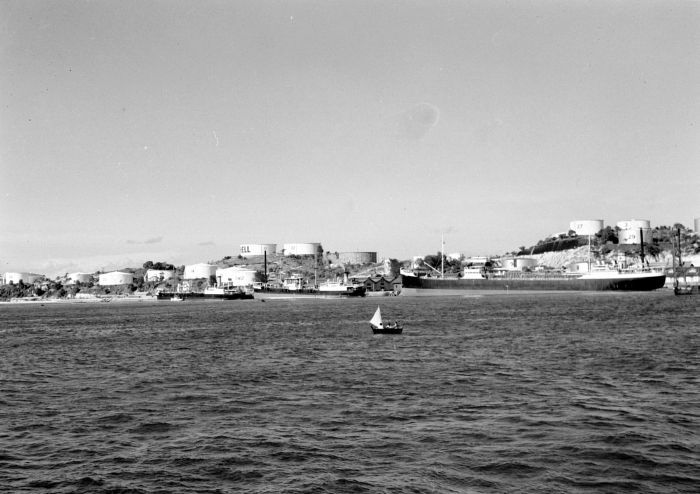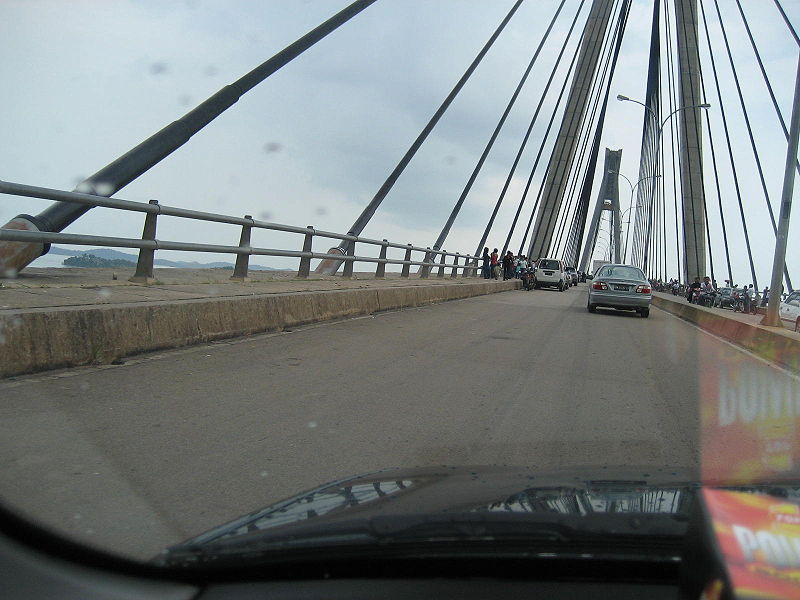|
Barelang
The Barelang Bridge ( Jawi:جمبتن باريلڠ ; ; id, Jembatan Barelang) is a chain of 6 bridges of various types that connect the islands of Batam, Rempang, and Galang, Riau Islands built in 1997. ''Barelang'' also refers to the islands themselves, which are all administratively part of the municipality of Batam. The smaller islands of Tonton, Nipah, and Setotok (considered parts of the Batam island group) connect Batam and Rempang, while a further small island - Galang Baru - is connected at the southern end of the chain. The entire Barelang region covers 715 km². Some locals call the bridge ''Jembatan Habibie'' after Jusuf Habibie, who oversaw the project in construction, aiming to transform the Rempang and Galang islands into industrial sites (resembling present-day Batam). The concept design for the 6 bridges were proposed by Bruce Ramsay of VSL. Habibie had requested that the designs should be based on a variation of different structural bridge types, in or ... [...More Info...] [...Related Items...] OR: [Wikipedia] [Google] [Baidu] |
Batam
Batam is the largest city in the province of Riau Islands, Indonesia. The city administrative area covers three main islands of Batam, Rempang, and Galang (collectively called Barelang), as well as several small islands. Batam Island is the core urban and industrial zone, while both Rempang Island and Galang Island maintain their rural character and are connected to Batam Island by short bridges. Batam is an industrial boomtown, an emerging transport hub, and part of a free trade zone in the Indonesia–Malaysia–Singapore Growth Triangle, located off Singapore's south coast and also part of the Indonesia–Malaysia–Thailand Growth Triangle. According to Statistics Indonesia's 2020 census, Batam had a population of 1,196,396, making it the third largest city in the region of Sumatra, after Medan and Palembang. It is the closest part of Indonesia to Singapore, at a minimum land distance of 5.8 km. During the 2010 national census, Batam was the fastest-growing munici ... [...More Info...] [...Related Items...] OR: [Wikipedia] [Google] [Baidu] |
Rempang
Rempang is an island, located 2.5 km South-East of Batam, 165.83 km2. belonging to a group of three islands called (an abbreviation of Batam-Rempang-Galang) A member of the , in the province of Indonesia, Rempang is located just south of and north of [...More Info...] [...Related Items...] OR: [Wikipedia] [Google] [Baidu] |
Galang Island
Galang (Indonesian: Pulau Galang) is an island of 80 km2 located 25 mi (40 km) southeast of Batam, belonging to a group of three islands called Barelang (an abbreviation of Batam-Rempang-Galang). Part of the Riau Archipelago, Indonesia, Galang is located just south of Batam and Rempang which themselves are just south of Singapore and Johor. Administratively, all three islands form part of the city of Batam; the nearest other city to Galang is Tanjungpinang on Bintan island, about a 30-minute boat ride away. The island is connected by the Barelang Bridge to Rempang and Batam. There was a UNHCR administration office established in Galang to run the Galang Refugee Camp during the 1979-1996 period. Many Vietnamese boat people and asylum seekers were temporarily accommodated in the Galang camp during the determination of their refugee status and their subsequent resettlement in the United States, Australia, and some European countries. Many Vietnamese from their new rese ... [...More Info...] [...Related Items...] OR: [Wikipedia] [Google] [Baidu] |
Cantilever Bridge
A cantilever bridge is a bridge built using structures that project horizontally into space, supported on only one end (called cantilevers). For small footbridges, the cantilevers may be simple beam (structure), beams; however, large cantilever bridges designed to handle road or rail traffic use trusses built from structural steel, or box girders built from prestressed concrete. The steel truss cantilever bridge was a major engineering breakthrough when first put into practice, as it can span distances of over , and can be more easily constructed at difficult crossings by virtue of using little or no falsework. Origins Civil engineer, Engineers in the 19th century understood that a bridge that was continuous across multiple supports would distribute the loads among them. This would result in lower stresses in the girder or truss and meant that longer spans could be built. Several 19th-century engineers patented continuous bridges with hinge points mid-span. The use of a hing ... [...More Info...] [...Related Items...] OR: [Wikipedia] [Google] [Baidu] |
Concrete Bridges
Concrete is a composite material composed of fine and coarse aggregate bonded together with a fluid cement (cement paste) that hardens (cures) over time. Concrete is the second-most-used substance in the world after water, and is the most widely used building material. Its usage worldwide, ton for ton, is twice that of steel, wood, plastics, and aluminum combined. Globally, the ready-mix concrete industry, the largest segment of the concrete market, is projected to exceed $600 billion in revenue by 2025. This widespread use results in a number of environmental impacts. Most notably, the production process for cement produces large volumes of greenhouse gas emissions, leading to net 8% of global emissions. Other environmental concerns include widespread illegal sand mining, impacts on the surrounding environment such as increased surface runoff or urban heat island effect, and potential public health implications from toxic ingredients. Significant research and development is ... [...More Info...] [...Related Items...] OR: [Wikipedia] [Google] [Baidu] |
Road Bridges
A bridge is a structure built to span a physical obstacle (such as a body of water, valley, road, or rail) without blocking the way underneath. It is constructed for the purpose of providing passage over the obstacle, which is usually something that is otherwise difficult or impossible to cross. There are many different designs of bridges, each serving a particular purpose and applicable to different situations. Designs of bridges vary depending on factors such as the function of the bridge, the nature of the terrain where the bridge is constructed and anchored, and the material used to make it, and the funds available to build it. The earliest bridges were likely made with fallen trees and stepping stones. The Neolithic people built boardwalk bridges across marshland. The Arkadiko Bridge (dating from the 13th century BC, in the Peloponnese) is one of the oldest arch bridges still in existence and use. Etymology The ''Oxford English Dictionary'' traces the origin of the w ... [...More Info...] [...Related Items...] OR: [Wikipedia] [Google] [Baidu] |
Cantilever Bridges
A cantilever bridge is a bridge built using structures that project horizontally into space, supported on only one end (called cantilevers). For small footbridges, the cantilevers may be simple beams; however, large cantilever bridges designed to handle road or rail traffic use trusses built from structural steel Structural steel is a category of steel used for making construction materials in a variety of shapes. Many structural steel shapes take the form of an elongated beam having a profile of a specific cross section. Structural steel shapes, sizes, ..., or box girders built from prestressed concrete. The steel truss cantilever bridge was a major engineering breakthrough when first put into practice, as it can span distances of over , and can be more easily constructed at difficult crossings by virtue of using little or no falsework. Origins Civil engineer, Engineers in the 19th century understood that a bridge that was continuous across multiple supports would dis ... [...More Info...] [...Related Items...] OR: [Wikipedia] [Google] [Baidu] |
Arch Bridges
An arch bridge is a bridge with abutments at each end shaped as a curved arch. Arch bridges work by transferring the weight of the bridge and its loads partially into a horizontal thrust restrained by the abutments at either side. A viaduct (a long bridge) may be made from a series of arches, although other more economical structures are typically used today. History Possibly the oldest existing arch bridge is the Mycenaean Arkadiko Bridge in Greece from about 1300 BC. The stone corbel arch bridge is still used by the local populace. The well-preserved Hellenistic Eleutherna Bridge has a triangular corbel arch. The 4th century BC Rhodes Footbridge rests on an early voussoir arch. Although true arches were already known by the Etruscans and ancient Greeks, the Romans were – as with the vault and the dome – the first to fully realize the potential of arches for bridge construction. A list of Roman bridges compiled by the engineer Colin O'Connor features 330 Ro ... [...More Info...] [...Related Items...] OR: [Wikipedia] [Google] [Baidu] |
Cable-stayed Bridges In Indonesia
A cable-stayed bridge has one or more ''towers'' (or ''pylons''), from which cables support the bridge deck. A distinctive feature are the cables or stays, which run directly from the tower to the deck, normally forming a fan-like pattern or a series of parallel lines. This is in contrast to the modern suspension bridge, where the cables supporting the deck are suspended vertically from the main cable, anchored at both ends of the bridge and running between the towers. The cable-stayed bridge is optimal for spans longer than cantilever bridges and shorter than suspension bridges. This is the range within which cantilever bridges would rapidly grow heavier, and suspension bridge cabling would be more costly. Cable-stayed bridges were being designed and constructed by the late 16th century, and the form found wide use in the late 19th century. Early examples, including the Brooklyn Bridge, often combined features from both the cable-stayed and suspension designs. Cable-stayed ... [...More Info...] [...Related Items...] OR: [Wikipedia] [Google] [Baidu] |
Bridges In Indonesia
A bridge is a structure built to span a physical obstacle (such as a body of water, valley, road, or rail) without blocking the way underneath. It is constructed for the purpose of providing passage over the obstacle, which is usually something that is otherwise difficult or impossible to cross. There are many different designs of bridges, each serving a particular purpose and applicable to different situations. Designs of bridges vary depending on factors such as the function of the bridge, the nature of the terrain where the bridge is constructed and anchored, and the material used to make it, and the funds available to build it. The earliest bridges were likely made with fallen trees and stepping stones. The Neolithic people built boardwalk bridges across marshland. The Arkadiko Bridge (dating from the 13th century BC, in the Peloponnese) is one of the oldest arch bridges still in existence and use. Etymology The ''Oxford English Dictionary'' traces the origin of the w ... [...More Info...] [...Related Items...] OR: [Wikipedia] [Google] [Baidu] |
Bridges Completed In 1997
A bridge is a structure built to span a physical obstacle (such as a body of water, valley, road, or rail) without blocking the way underneath. It is constructed for the purpose of providing passage over the obstacle, which is usually something that is otherwise difficult or impossible to cross. There are many different designs of bridges, each serving a particular purpose and applicable to different situations. Designs of bridges vary depending on factors such as the function of the bridge, the nature of the terrain where the bridge is constructed and anchored, and the material used to make it, and the funds available to build it. The earliest bridges were likely made with fallen trees and stepping stones. The Neolithic people built boardwalk bridges across marshland. The Arkadiko Bridge (dating from the 13th century BC, in the Peloponnese) is one of the oldest arch bridges still in existence and use. Etymology The ''Oxford English Dictionary'' traces the origin of the wo ... [...More Info...] [...Related Items...] OR: [Wikipedia] [Google] [Baidu] |
.jpg)




